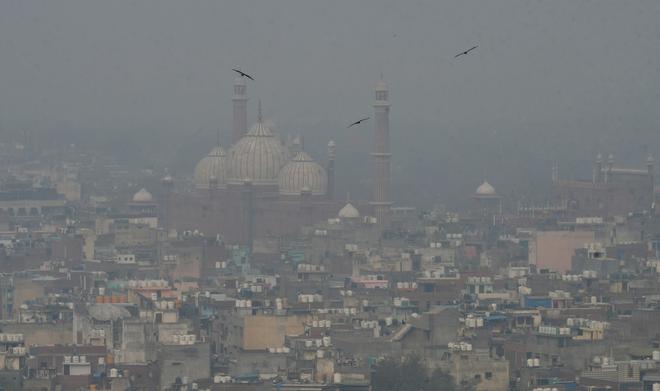It’s the first week of November and Delhi is blanketed in smog. But buses full of children in school uniform head towards Lodi Garden, a sprawling park in the heart of the city, and groups of people amble towards India Gate, a war memorial. It is rare to see faces covered with N95 masks, despite the air quality index (AQI) hitting the severe-plus 500 mark and the government banning construction and the plying of certain types of vehicles as emergency measures to control air pollution.
But on the fifth floor of a building at the All India Institute of Medical Sciences, the largest government hospital in Delhi, 39-year-old Fauzia Begum’s brother wheels her into a doctor’s room. A white tube from an oxygen cylinder, attached to a side of the wheelchair, splits into two. They go into Begum’s nostrils.
Begum coughs. “Her condition got worse over the last week due to the pollution,” her brother tells the doctor. In a low voice, Begum adds, “It’s hard to breathe. I can’t sit and I feel very weak. What should I do?”
“This month is very bad,” the doctor replies. “Every year, you will have to take this injection in November-December,” he adds and scribbles a list of medicines on her file.
Outside the room, Begum’s brother says her condition had worsened during this time last year too, when Delhi’s air became thick, brown, and toxic. “She was better and could breathe with us running the oxygen at 2 (litres per minute),” he says. “About two weeks ago, she started getting breathless and we increased it to 3. But she was still not fine, so we had to increase it to 4,” he says. Begum used to be more active than him, he rues.
“Now, I only go to hospital,” says Begum.
A north-centric problem
Many other patients show a similar pattern, says Dr. Vijay Hadda, Additional Professor (Pulmonary Medicine) at AIIMS. He termed pollution a “hidden killer” that affects “almost every organ.” Air pollution has been linked to lung cancer, stroke, heart attack, and many other diseases. About 1.67 million Indians died prematurely in 2019 alone due to air pollution, accounting for 18% of all fatalities, according to a report published by The Lancet last year.
India ranks eighth in the list of countries with the worst air quality index, according to the Annual World Air Quality Report released by Swiss air quality technology company, IQAir, earlier this year. To make matters worse, of the top 20 most polluted cities in the world, 14 were from north India.
Poor air is therefore not just a Delhi problem. Every year, especially during winter, air pollution spikes in the entire Indo-Gangetic Plain. This region, covering large parts of Delhi, Haryana, Punjab, and eastern Uttar Pradesh, constitutes an airshed, which means that roughly the same atmospheric conditions prevail everywhere.
Pollution spikes when pollutants from different sources are not dispersed easily in winter because of a drop in wind speed and temperature. Vehicle and diesel generator exhaust, heavy industry emissions, soil and road dust, open waste burning, and biomass burning are all present in the atmosphere throughout the year. In winter they get accumulated, amplifying the effects of the pollutants compared to summer. The pollution from stubble burning, a practice of removing paddy crop residue from fields to sow wheat, which happens in October-November, makes the situation worse.
This November too, air pollution spiked in the Indo-Gangetic Plain and a toxic smog covered the national capital for about a week. Delhi remained the ‘most polluted’ major city in the world for many days in November, according to IQAir’s live data for over 100 cities.
Calling it a “murder of the health of the people,” the Supreme Court cracked the whip on the government. Among other directions, it ordered Punjab, Haryana, Uttar Pradesh, and Rajasthan to stop stubble burning “forthwith”.

Last week, while the Bharatiya Janata Party (BJP) blamed the Aam Aadmi Party (AAP)-ruled Punjab for stubble burning in the State, the AAP hit back saying this is a north Indian problem for which the BJP has no plan. Paddy stubble burning, a politically sensitive issue, takes place only during the harvest period of September 15-November 30.
Fewer stubble burning incidents
The good news is that the number of stubble-burning incidents in the region are falling, according to the Consortium for Research on Agroecosystem Monitoring and Modelling from Space Lab, run by the Indian Agricultural Research Institute. In 2022, the number of farm fires fell in Punjab, Haryana, and Uttar Pradesh compared to the previous year.
This year too, there is a fall. According to data from the Punjab Pollution Control Board (PPCB), collected through satellite imagery, the State recorded 22,981 stubble-burning incidents from September 15 to November 8. Sangrur, the home district of Chief Minister Bhagwant Mann, recorded the highest number of farm fires at 4,070. Last year, 33,090 such incidents were recorded during the same period in the State. These figures show that while farm fires have reduced, they are still high in absolute numbers.
On October 22 this year, stubble burning accounted for about 16% of the PM2.5 particulate matter in Delhi. It increased to nearly 35% on November 3, the highest this season, when the AQI broke into the most toxic category, according to a tracker maintained by the Earth Sciences Ministry.
Meteorological factors play a significant role in determining the degree of particulate matter coming in from stubble burning outside of Delhi-NCR. “It was surprising that multiple weather factors combined between October 26-31,” says Professor Sachchida Nand Tripathi, an authority on atmospheric sciences, at IIT Kanpur. “The boundary layer dropped by 50%, the wind direction changed from north-east to northwest, and the columnar winds were as low as they can get. It’s well known that these values will correspond to the worst pollution levels,” he says. The boundary layer refers to the height at which pollutants hover. If it’s too low, natural wind drafts cannot flush the pollutants away. The same goes for columnar wind.
‘We burn stubble out of compulsion’
As stubble burning is a significant factor, though not solely responsible for the spike in pollution, as Tripathi says, it also dominates conversations in Punjab. In Fatehpur, a village on the outskirts of Patiala city, winter is setting in. It is that time of the year when farmers in Punjab and Haryana race against time to harvest the paddy (summer) crop and prepare to sow the wheat (winter) crop.
Paddy, which is harvested with combine harvester machines, leaves behind a stubble on the field. Many farmers find burning the crop residue to be the most “effective and cheap” method when they want to prepare their farm to sow wheat. As they have only three weeks between the harvest of paddy and the sowing of wheat, farmers resort to stubble burning.
Farmers across Punjab annually face the challenge of managing nearly 20 million tonnes of paddy straw. It is estimated by the State government that over 15 million tonnes of paddy straw are burnt in open fields to clear the land for sowing wheat or other crops.
Ajit Singh (name changed to protect privacy), 58, is aware of the 2015 order of National Green Tribunal, which bans stubble burning. But the owner of a 14-acre family farm says he is helpless.
“Most farmers don’t want to set stubble on fire,” he says. “They do it out of compulsion. We are the first victims of the pollution from crop burning, so why would we want that? The problem is that successive governments have failed to provide us with viable options to manage the crop residue.”
He adds that if farmers were given machines or financial incentives by the government “in a time-bound manner,” they wouldn’t burn the residue.
For the last few years, the government has been providing crop residue management (CRM) machines, but even on subsidy, they are expensive, especially for small and marginal farmers. They are also not available on time. This year, the government has been promoting the use of balers (machines designed to compress crop residue into compact bales).
“The problem remains the same: they are not available when we need them,” Ajit says.
In the village, a group of farmers meet close to a pond. They debate the controversial incident of some farmers in a village in Bathinda forcing a government official to burn paddy straw in a field last week. A first information report was registered against the perpetrators. Mann said that “the State government can’t be a mute spectator to this incident and allow anarchy to prevail.”
The farmers say the problem is deeper. “Mechanisation is only a partial solution. The government needs to promote crop diversification, which is only possible through a minimum support price and assured purchase of the produce for other crops on the lines of paddy and wheat,” says Gurpreet Singh, 35, who has been using a super-seeder machine for removing paddy stubble. These machines plough standing paddy stubble in soil and sow wheat seed simultaneously in a single operation.
Amarjit Singh (name changed), of Bari village in Sahibzada Ajit Singh Nagar district, says the private bale operator he had approached asked him to pay ₹800 per acre to have his field cleared. Amarjit refused. “I can’t bear that cost as it adds to the cost of cultivation. Why can’t the government make an arrangement to lift the stubble from our fields,” he says.
In Rupnagar district’s Rolu Majra village, Pargat Singh, in his 70s, who has cultivated paddy in a 14-acre farm, says farmers have been demanding ₹2,500-3,000 per acre from the government for many years: “If they pay us this, we will not burn the stubble because we can opt for scientific methods to dispose of the residue.”
There has been an encouraging response for balers from farmers this year, says Jaswant Singh, Director of the Punjab Agriculture Department. “The demand has gone up significantly this season. Most of these balers are imported. The companies in the business had procured balers keeping in view the routine demand. But given this sudden rise, we have had a problem of shortage. We hope it is resolved soon.”
With no quick solutions in sight, farmers have reluctantly been burning paddy, which has caused air pollution to spike in the last fortnight in Punjab. The AQI has slipped from the ‘moderate’ to ‘poor’ category. Experts fear that with close to 20% of area of paddy yet to be harvested, pollution will only spike further.
Asserting that the number of hospital patients with respiratory diseases has gone up in the last few days, Dr. Aslam Parvez, president of Punjab Rural Medical Services Association, says, “Stubble burning triggers respiratory disease. We are seeing more and more patients with cough, runny nose, itchy eyes, besides skin diseases.”
Government initiatives
For the management of crop residue, the Punjab government has been providing subsidies on the purchase of CRM machines, including surface seeders, an in-situ paddy stubble management device. The State government has mandated that brick kilns use stubble as fuel and that other plants buy stubble from farmers.
Gurpreet Singh Kuthala, from Ferozepur-Kuthala village in Malerkotla district, says that the demand for stubble from biomass energy plants, industrial boilers, and paper cardboard mills has seen an uptick this year. This is fetching the farmers a good price.
“Last year, I bought a rake and baler on government subsidy for stubble management. I cleared stubble in 600 acres and earned around ₹20 lakh by selling bales. This year, I expect the area to go up to 2,000 acres. I don’t charge anything from the farmers. I have entered into an agreement with a compressed bio-gas plant situated in Sangrur. They pay ₹170 per quintal for the bale,” he says.
P.S. Rangi, former adviser to the Punjab State Farmers Commission, says the State has over 10 lakh farming families who have land holdings of 2-5 acres and cannot afford to opt for mechanised farming. “While supplying agro-machines on subsidy may reduce the problem of stubble burning to some extent, it is not a complete solution. These agro-machines are used for a limited period of time. They are of no use for the whole year. Also, they have no utility unless they are provided within the required time,” Rangi says.
To curb the menace of stubble burning, PPCB has been promoting paddy straw as a resource to create wealth. “The PPCB has been encouraging the use of paddy straw in power plants and industrial boilers. Demonstrative industrial boilers were installed and entrepreneurs are trying to replicate them in their units. Punjab has tackled technological challenges over the last two years. There have been metallurgical improvements in industrial boiler vessels and the supply chain of paddy straw has been strengthened. The efforts have resulted in 125% increase (to 4.5 million tonnes) in paddy straw usage from the previous year,” says Krunesh Garg, chief environmental engineer, PPCB.
Meanwhile in Delhi, though schools have shut, children continue to go out and play, and people party on and even burst firecrackers.
With inputs from Jacob Koshy







